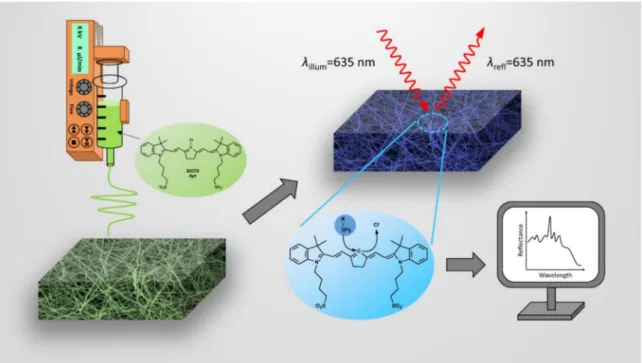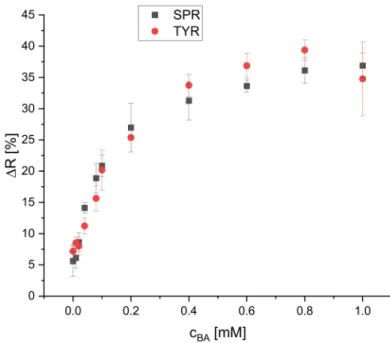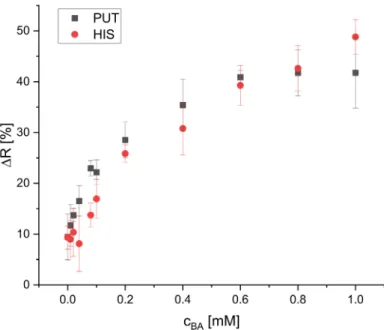Article
Dipsticks with Reflectometric Readout of an NIR Dye for Determination of Biogenic Amines
Sarah N. Mobarez
1,2, Nongnoot Wongkaew
1, Marcel Simsek
1, Antje J. Baeumner
1and Axel Duerkop
1,*
1
Institute of Analytical Chemistry, Chemo- and Biosensors, University of Regensburg, Universitätsstraße 31, 93053 Regensburg, Germany; Sarah-Nagy-Ali.Mobarez@chemie.uni-regensburg.de (S.N.M.);
Nongnoot.Wongkaew@chemie.uni-regensburg.de (N.W.); Marcel.Simsek@chemie.uni-regensburg.de (M.S.);
Antje.Baeumner@ur.de (A.J.B.)
2
Chemistry Department, Faculty of Science, Ain Shams University, El-Khalyfa El-Mamoun Street, El-Abaseya, Cairo 11566, Egypt
* Correspondence: axel.duerkop@ur.de; Tel.: +49-941-943-4063; Fax: +49-941-943-4064
Received: 6 August 2020; Accepted: 9 October 2020; Published: 14 October 2020
Abstract: Electrospun nanofibers (ENFs) are remarkable analytical tools for quantitative analysis since they are inexpensive, easily produced in uniform homogenous mats, and provide a high surface area-to-volume ratio. Taking advantage of these characteristics, a near-infrared (NIR)-dye was doped as chemosensor into ENFs of about 500 nm in diameter electrospun into 50 µm thick mats on indium tin oxide (ITO) supports. The mats were made of cellulose acetate (CA) and used as a sensor layer on optical dipsticks for the determination of biogenic amines (BAs) in food. The ENFs contained the chromogenic amine-reactive chameleon dye S0378 which is green and turns blue upon formation of a dye-BA conjugate. This S
N1-reaction of the S0378 dye with various BAs was monitored by reflectance measurements at 635 nm where the intrinsic absorption of biological material is low. The difference of the reflectance before and after the reaction is proportional to BA levels from 0.04–1 mM. The LODs are in the range from 0.03–0.09 mM, concentrations that can induce food poisoning but are not recognized by the human nose. The calibration plots of histamine, putrescine, spermidine, and tyramine are very similar and suggesting the use of the dipsticks to monitor the total sample BA content. Furthermore, the dipsticks are selective to primary amines (both mono- and diamines) and show low interference towards most nucleophiles. A minute interference of proteins in real samples can be overcome by appropriate sample pretreatment. Hence, the ageing of seafood samples could be monitored via their total BA content which rose up to 21.7 ± 3.2 µ mol/g over six days of storage. This demonstrates that optically doped NFs represent viable sensor and transducer materials for food analysis with dipsticks.
Keywords: dipstick; biogenic amine; electrospun nanofibers; NIR dye; food analysis; reflectometry
1. Introduction
Biogenic amines (BAs) are important compounds that can determine the quality of food [1].
High levels of amines in food are produced by bacterial decarboxylation of amino acids and have been recognized as an important reason for seafood intoxication [2]. Hence, the determination of the concentration of BAs in fresh food is in high need to determine its freshness status. Papageorgiou and co-workers gave a review on food and beverage products that should be regularly tested since they contain BAs or may develop certain contents over (storage) time [3]. This raises interest in research on rapid and inexpensive optical detection methods and tools like dipsticks to determine BAs in food, not only for individual concentration levels but also as a sum parameter. According to the European Food Safety Authority (EFSA), the U.S. Food and Drug Administration (FDA) as well as the
Chemosensors2020,8, 99; doi:10.3390/chemosensors8040099 www.mdpi.com/journal/chemosensors








